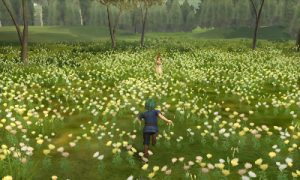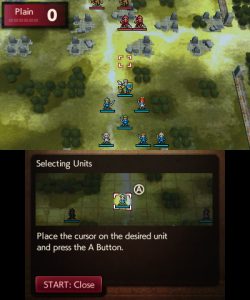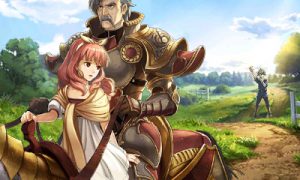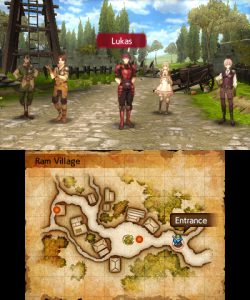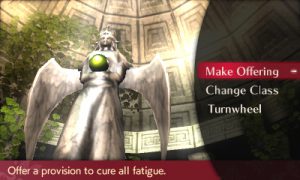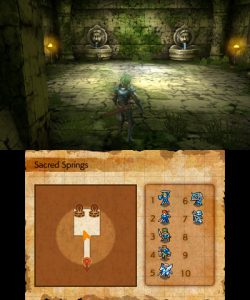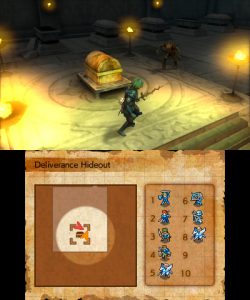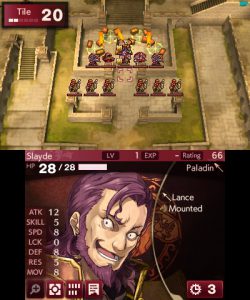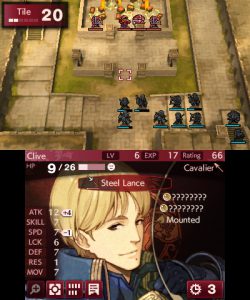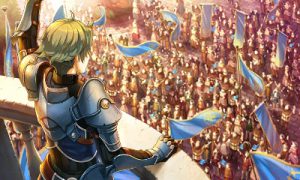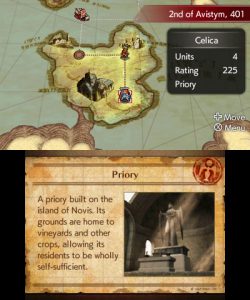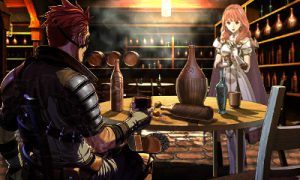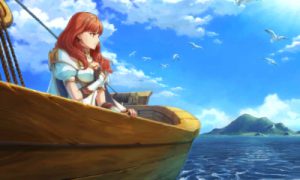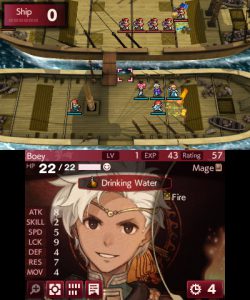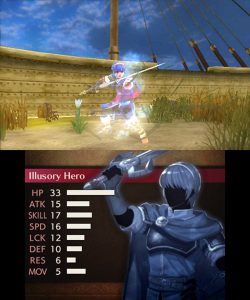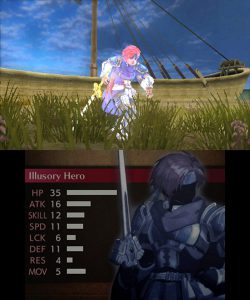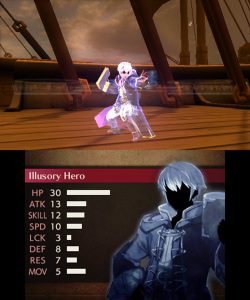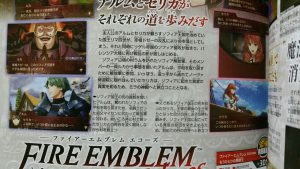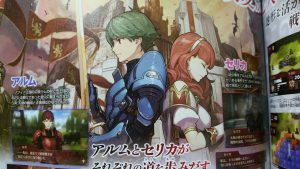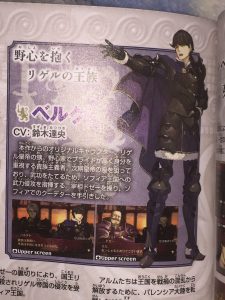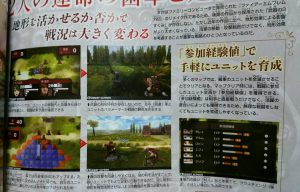With so much Fire Emblem-related news lately, it’s very easy to miss some details. Today, we’ll take a deeper look at some recently released screenshots from Fire Emblem Echoes: Shadows of Valentia.
The first batch of screenshots come directly from Nintendo themselves. Uploaded on 22nd March, these screenshots compliment the gameplay information provided in the 21st March press release.
The first three screenshots appear to occur during the new prologue, which explores Alm and Celica’s childhood days before they were torn apart. In the first screenshot, Alm is heading towards Celica.
We’ve seen this grassy field with flowers on multiple occasions. Most notably when Alm and Celica are studying their birthmarks, but also during the difficulty/mode selection. Considering the timing, it’s safe to assume all these events occur close to one another.
The second is from a new mission featuring Mycen and younger versions of Alm, Celica and their four friends from Ram Village (Tobin, Kliff, Gray and Faye). Like in Awakening and Fates, this flashback mission appears to double as a tutorial.
The third screenshot–and the final one of this set–shows Mycen taking Celica away from Ram Village, with Alm in the distance. We know that Celica left after an “incident”, which is probably the skirmish with the Zofian army in the second screenshot.
Years later, Alm and Celica’s adventures begin proper. For Alm, his journey is triggered after a visit from Lukas, a member of the Deliverance–a group aiming to overthrow the traitorous Desaix from Zofia Castle.
The above screenshot shows off the village exploration system, which has been overhauled since the days of Gaiden. Instead of walking around villages like in a traditional RPG, you navigate them like in a visual novel.
Here, we’re at the entrance of Ram Village where Lukas and Alm’s four villager friends are waiting. This looks like the very beginning of Gaiden, where you must speak to–and recruit–the four villagers (although there used to be three).
Although you can’t physically walk around the village, you can select three locations to travel to, as indicated by the circles on the map. The middle circle looks to be a tree, while the left-most circle might be Mycen’s home.
Moving on, we reach the innards of a dungeon. Inside most dungeons is a Mila’s Statue, which allows you to change class. However there are additional functions too.
The first option, “Make Offering” is fairly intriguing, allowing you to offer a provision (a food item, such as Bread) in exchange for an unclear health benefit.
The word “fatigue” brings back memories of Thracia 776′s notorious fatigue system, where units gained fatigue as they took actions. If a unit’s fatigue was too high, they would have to sit out a mission.
We don’t think Echoes will be this harsh though, especially as there aren’t enough units to cycle around. Not only that, but the already small cast is divided into two groups, further reducing the variety of units you can access per group.
That said, if characters do indeed get fatigued–and it’s not simply flavour text, maybe it will add a stat penalty (or some other penalty) instead. Perhaps this is related to the smiley face symbol next to a character’s HP?
The third option is related to Mila’s Turnwheel, which has the ability to rewind turns and summon amiibo. Since you can use the summon amiibo ability from the world map, perhaps this is where you replenish the turn-rewinding ability?
Next we have our first glimpse at the Sacred Springs, which can also be found in dungeons from time to time. In Gaiden, these provided a small stat boost–or the ability to resurrect a fallen ally, depending on the specific spring.
Originally, you could only use each spring a limited number of times (usually 3). Furthermore, this limit was shared by both springs in the same room, so you had to choose carefully.
The other things you’ll find in dungeons are enemies, destructible objects and chests. But you probably already knew that. Anyway, here we can clearly see Clair in Alm’s party (the 8th party member).
Previously, she was missing from Alm’s party since there were 11 members and you can only have 10, at least in dungeons. Interestingly, she has blonde hair, not blue. Perhaps to make her resemble her older brother Clive more.
Speaking of which, we have a pair of screenshots from the final map of Chapter 1, where Clive is featured on the player side (right). On the enemy side is Slayde (left), the villain from the prologue mission.
Looking at Clive, this is one of the few times we see a smiley face that isn’t in the “very happy” state. While it might look like it’s related to HP, Celica was “very happy” despite having 16/24 HP, while Valbar was merely “happy” with 25/31 HP.
Plus if the smiley face was related to HP, it would be extremely redundant since you can see the HP bar and numbers next to it.
Once this mission is complete, Alm is welcomed by the Zofians as their saviour. Some fans have pointed out an interesting parallel with Marth’s liberation of Altea in Shadow Dragon.
Although this sort of imagery–with a hero waving to the crowd–isn’t very unique, considering the game’s Japanese subtitle is “Another Hero-King”, this could be another nod to Alm being the “Marth” of Valentia.
It’s Celica’s turn next. While Alm is busying rescuing Zofia, Celica leaves on a journey to the Temple of Mila to seek answers about the strange happenings across Valentia. By this time, the season has shifted to Avistym (the season of birds).
So far, we also have Pegastym (the season of pegasi) during Chapter 3 and the season of flowers during Chapter 1 (which, as far as we know, has not appeared in English screenshots yet).
Being the other main character of the game, Celica features in a fair number of cutscene art as well. In the first, she’s convincing Saber the Mercenary to join her cause. Meanwhile the second shows her on a ship heading towards the Zofian mainland.
In typical Fire Emblem tradition, even the ships aren’t safe. In fact, Gaiden–which Echoes is based on–was the first game to feature ship battles. The interesting thing here is that the gear icon–related to Mila’s Turnwheel–is 4, the highest value we’ve seen so far.
Previously, it was always 3. Right now, we still don’t know what this number means–maybe the maximum number of actions you can rewind? Also, it’s still a mystery how Celica can use Mila’s Turnwheel; we know Alm gets his from Silque.
Finally, we have a trio of screenshots showcasing the illusory heroes summoned via amiibo. There’s literally no way you can mistake these for anything but phantoms. Besides Marth, Roy and Robin, the likes of Ike, Lucina and Corrin can be summoned too.
That’s all for the official screenshots, but we also have some off-camera screenshots taken from this month’s issue of Nintendo Dream. A big thanks to the kind individual(s) who took and shared these pictures!
Now most of the information is basically the same as in this week’s Famitsu. Which shouldn’t be too strange since most people probably only buy one magazine. But since Nintendo Dream is monthly, it tends to pack in some extra pictures and tidbits.
That said, a lot of the pictures are pretty straightforward though, showing examples of basic gameplay or early-game dialogue. Plus hilarious imagery of an evil-looking Desaix towering over Zofia Castle.
In the above snippet, there’s a curious screenshot of Celica towards the top-right corner. From appearances, the main character (Alm or Celica) always appears on the bottom screen during dialogue scenes.
In this setup, Alm and Celica’s dialogue is still displayed along the top screen. This would explain why the character(s) they’re talking to (on the top screen) are facing forward. They’re not looking at you–the player–but Alm and Celica.
The above two snippets feature our first in-game look at Nomah (to the right of the left snippet) and Berkut’s mystery horse-riding companion (the left-most screenshot in the right snippet).
Finally, in the bottom-right corner of this snippet is a discussion of the “participation experience” system. Like in Gaiden, it seems units can contribute to a pool of experience, which is then shared out among all members at the end of a battle.
This allows all units to receive some experience, even if they didn’t fight or do anything. The red portion of the experience bar indicates the participation experience, while the numbers at the end correspond to the units’ total experience.
Strangely, the smiley face icons show up again, despite being seemingly out of place. Of the lot, Gray and Faye are “happy”, while everyone else is “very happy”. However it doesn’t seem to directly affect the participation experience.
